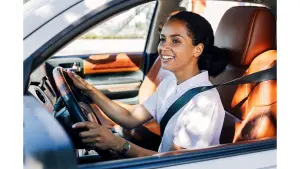Imagine you're driving down a winding road, the sun shining and the wind blowing through your hair. Suddenly, out of nowhere, a deer leaps onto the road right in front of you! You slam on the brakes, narrowly avoiding a collision. This heart-pounding moment reminds us of the importance of defensive driving.
As a teen, you're just starting to navigate the roads on your own, and it's crucial to have the keys to defensive driving. By maintaining a safe distance, anticipating potential hazards, and avoiding distractions, you can stay in control and prevent accidents.
So buckle up, grab the wheel, and let's explore the essential skills that will keep you safe behind the wheel.
Importance of Defensive Driving
To become a safe and responsible driver, it's essential for you to understand the importance of defensive driving. Defensive driving techniques are crucial for avoiding accidents and minimizing risks on the road. By being aware of your surroundings and anticipating potential hazards, you can take proactive measures to protect yourself and others.
One way to develop these skills is by taking a defensive driving course. These courses provide valuable instruction on how to recognize and respond to dangerous situations. They teach you how to maintain a safe following distance, use your mirrors effectively, and avoid distractions while driving. Additionally, defensive driving courses educate you on proper lane changing, intersection navigation, and handling adverse weather conditions.
By incorporating these defensive driving techniques into your everyday driving habits, you can significantly reduce the likelihood of being involved in a collision. Defensive driving isn't just about reacting to other drivers' mistakes, but also about making proactive decisions to prevent accidents from happening in the first place.
Maintaining a Safe Distance
Maintain a safe distance between your car and the vehicle ahead of you to minimize the risk of rear-end collisions. This is crucial for your safety on the road. By keeping a safe distance, you allow yourself enough time to react to any sudden changes in the traffic flow.
To maintain focus, always keep your eyes on the road ahead and avoid distractions such as using your phone or adjusting the radio. This will help you anticipate potential hazards and adjust your driving accordingly.
Remember to adjust your following distance based on road conditions. In adverse weather conditions or heavy traffic, it's essential to increase your following distance. This will give you more time to react if the vehicle ahead suddenly stops or slows down. Additionally, maintaining a safe distance in these situations will help prevent skidding or losing control of your vehicle.
To determine a safe following distance, use the three-second rule. Choose a fixed object on the road, such as a sign or a lamppost, and when the vehicle ahead passes it, start counting. If you reach the same object before you finish counting to three, you need to increase your following distance.
Always remember that maintaining a safe distance is an essential defensive driving technique that can help prevent accidents and keep you and others safe on the road.
Anticipating Potential Hazards
One key aspect of defensive driving is actively anticipating potential hazards on the road, ensuring that you're prepared to react in a timely and safe manner. Developing situational awareness is crucial in this process. It means being aware of your surroundings, constantly scanning the road ahead, and staying alert to any potential dangers. By doing so, you can identify potential hazards before they become immediate threats.
Recognizing road conditions is another important factor in anticipating potential hazards. Different road conditions require different responses. For example, wet or icy roads can reduce traction and increase the risk of skidding. In these situations, it's important to adjust your speed and maintain a safe following distance to allow for increased stopping time. Similarly, construction zones or areas with heavy traffic may require extra caution and a slower speed to navigate safely.
Anticipating potential hazards allows you to proactively take steps to avoid accidents. It gives you the time and space needed to react appropriately, whether it's by slowing down, changing lanes, or avoiding obstacles. Remember to always be aware of your surroundings, stay focused, and keep a safe distance from other vehicles.
Defensive driving is about being prepared and proactive, ensuring your safety and the safety of those around you.
Avoiding Distractions
Stay focused and minimize distractions while driving to ensure your safety and the safety of others on the road. Distracted driving can have serious consequences, leading to accidents, injuries, and even fatalities. It's important to recognize the various distractions that can divert your attention from the road and implement strategies to stay focused.
One effective strategy is to eliminate physical distractions. Before you start driving, make sure your phone is out of reach and silenced. Avoid eating or drinking while driving, as it can take your hands off the wheel and your eyes off the road. Keep your focus on driving and avoid using in-car technologies that can distract you, such as touchscreens or voice command systems.
Mental distractions can also impair your ability to drive safely. Avoid daydreaming, excessive conversations with passengers, or becoming too engrossed in your thoughts. If you find your mind wandering, take a moment to refocus and bring your attention back to the road.
Another important strategy is to plan ahead. Set your GPS or familiarize yourself with the directions before you start driving. This will minimize the need to look at maps or GPS while driving, reducing the risk of distraction.
Building Confidence and Responsibility
To build confidence and responsibility behind the wheel, it's crucial for teen drivers to actively engage in ongoing practice and education. Developing situational awareness is a key aspect of building confidence on the road. This means being able to anticipate and react to potential hazards and changes in traffic conditions. By staying alert and aware of their surroundings, teen drivers can make better decisions and avoid dangerous situations.
Additionally, following traffic rules is essential for responsible driving. Understanding and obeying speed limits, stop signs, and traffic signals not only keeps teen drivers safe but also demonstrates their commitment to being responsible road users. It's important for teens to realize that being a defensive driver means not only protecting themselves but also other drivers, passengers, and pedestrians.
Frequently Asked Questions
How Can Defensive Driving Help Prevent Accidents Caused by Other Drivers' Mistakes?
Defensive driving can prevent accidents caused by other drivers' mistakes by teaching you to avoid aggressive drivers and emphasizing the importance of situational awareness. Stay alert and anticipate potential hazards to stay safe on the road.
What Are Some Effective Strategies for Avoiding Distractions While Driving?
To avoid distractions while driving, you need to implement effective strategies. The importance of focus cannot be stressed enough. Stay away from your phone, keep the music at a reasonable volume, and avoid eating or doing anything that takes your attention away from the road.
What Are the Consequences of Tailgating and Not Maintaining a Safe Distance?
Tailgating and not maintaining a safe distance can have serious consequences. You risk rear-ending the car in front of you, causing injury, damage, and even death. It's crucial to keep a safe distance to ensure everyone's safety on the road.
How Can Teenage Drivers Build Confidence in Their Defensive Driving Skills?
To build your defensive driving skills and overcome anxiety, practice regularly, take a defensive driving course, and familiarize yourself with traffic laws. Confidence comes with experience, so keep learning and stay focused on the road.
Are There Any Specific Tips for Anticipating Potential Hazards in Different Weather Conditions?
When driving in fog, slow down and use your low-beam headlights. Keep a safe following distance and use road markings as a guide. In heavy rain, turn on your wipers and headlights, and maintain a slower speed to prevent hydroplaning.






